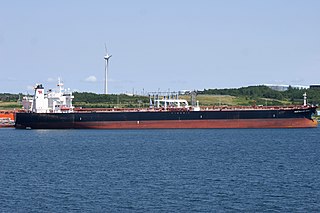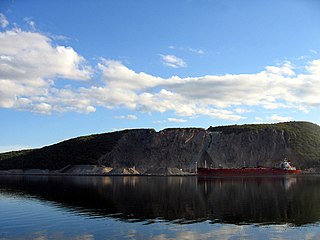Related Research Articles

Captains Courageous: A Story of the Grand Banks is an 1897 novel by Rudyard Kipling that follows the adventures of fifteen-year-old Harvey Cheyne Jr., the spoiled son of a railroad tycoon, after he is saved from drowning by a Portuguese fisherman in the North Atlantic. The novel originally appeared as a serialisation in McClure's, beginning with the November 1896 edition with the last instalment appearing in May 1897. In that year, it was published in its entirety as a novel, first in the United States by Doubleday, and a month later in the United Kingdom by Macmillan. It is Kipling's only novel set entirely in North America. In 1900, Teddy Roosevelt extolled the book in his essay "What We Can Expect of the American Boy", praising Kipling for describing "in the liveliest way just what a boy should be and do".

Port Hawkesbury is a municipality in southern Cape Breton Island, Nova Scotia, Canada. While within the historical county of Inverness, it is not part of the Municipality of Inverness County.

The Strait of Canso separates mainland Nova Scotia and Cape Breton Island, in eastern Canada.

Riverport is a village in Lunenburg County, Nova Scotia, Canada. The harbour of Ritcey Cove is free from shoals and safe from every wind, considered one of the finest in North America. Riverport is a five-minute drive to several public beaches including Hirtle's Beach, Kingsburg Beach, Oxner Beach, Rose Bay Beach and Spindler Beach.

Farley Boats set the standard along the Gulf Coast for fishing and sport from 1915 to the mid-1970s. Three generations of the Farley family designed and built the Farley Boat in the back of their home in Port Aransas, Texas.
Gilbert Clarence Klingel (1908–1983) was a naturalist, boatbuilder, adventurer, photographer, author, inventor, contributor to the Baltimore Sun, for a time affiliated with the American Museum of Natural History in New York and a member of the Maryland Academy of Sciences, and a curator and charter member of the Natural History Society of Maryland. He is best known for his book about the Chesapeake Bay, The Bay, which won the John Burroughs Medal in 1953.

Literally, the word pinisi refers to a type of rigging of Indonesian sailing vessels. A pinisi carries seven to eight sails on two masts, arranged like a gaff-ketch with what is called 'standing gaffs' — i.e., unlike most Western ships using such a rig, the two main sails are not opened by raising the spars they are attached to, but the sails are 'pulled out' like curtains along the gaffs which are fixed at around the centre of the masts.

Fishing in Cornwall, England, UK, has traditionally been one of the main elements of the economy of the county. Pilchard fishing and processing was a thriving industry in Cornwall from around 1750 to around 1880, after which it went into an almost terminal decline. During the 20th century the varieties of fish taken became much more diverse and crustaceans such as crab and lobster are now significant. Much of the catch is exported to France due to the higher prices obtainable there. Though fishing has been significantly damaged by overfishing, the Southwest Handline Fishermen's Association has started to revive the fishing industry. As of 2007, stocks were improving. The Cornwall Sea Fisheries Committee is one of 12 committees responsible for managing the corresponding Sea Fisheries District. The Isles of Scilly Sea Fisheries Committee is responsible for the Scilly district.
J W Miller & Sons Ltd was a boatbuilder in St Monans, Fife, Scotland for over 200 years. They produced a variety of fishing boats, yachts and motor launches. The firm built 110 Fifie yachts and was known worldwide for the quality and craftsmanship of their vessels. The yard is now closed.

USS Raeo (SP-588) was a United States Navy patrol vessel in commission from 1917 to 1919. Prior to her U.S. Navy service, she operated as the motor passenger vessel Raeo from 1908 to 1917. After the conclusion of her U.S. Navy career, she served as the fishery patrol vessel USFS Kittiwake in the United States Bureau of Fisheries fleet from 1919 to 1940 and as US FWS Kittiwake in the Fish and Wildlife Service fleet from 1940 to 1942 and from 1944 to at least 1945, and perhaps as late as 1948. During World War II, she again served in the U.S. Navy, this time as the yard patrol boat USS YP-199. She was the civilian fishing vessel Raeo from 1948 to 1957, then operated in various roles as Harbor Queen from 1957 to 1997. She became Entiat Princess in 1998 and as of 2009 was still in service.
Lars Halvorsen Sons was an Australian pleasure craft and boat building company, described as "one of the most famous [names] in Australian marine engineering".

Sherman Zwicker is a wooden auxiliary fishing schooner built in 1942 at the Smith and Rhuland shipyard, Lunenburg, Nova Scotia. Influenced by the design of the famous Bluenose, Sherman Zwicker was built to fish the Grand Banks. The schooner was built for F. Homer Zwicker of Zwicker and Co. Officially christened in 1942, the F/V Sherman Zwicker is the last operable saltbank fishing vessel in existence.

Naga Pelangi is a wooden junk rigged schooner of the Malay pinas type built using traditional lashed-lug techniques from 2004 to 2009 in Kuala Terengganu, Malaysia. Finished in 2010, it is operated as a charter vessel in South East Asia.

The pinas, sometimes called "pinis" as well, is a type of schooner of the east coast of the Malay peninsula, built in the Terengganu area. This kind of vessel was built of Chengal wood by the Malays since the 19th century and roamed the South China Sea and adjacent oceans as one of the two types of traditional sailing vessels the late Malay maritime culture has developed: The bedar and the pinas.

The term bedar is applied to a wide variety of boats of the east coast of Malaysia that carry one or two junk sails and lack the typical transom stern of the perahu pinas. These junk rigged boats are usually built in the Terengganu area. The stern of the bedar is a classical "canu" or "pinky stern," being a typical "double ender", a bit like a modern ship's lifeboat, with a very full turn of the bilge and with markedly raked stem and stern. They came in small versions as small one-masted fishing vessels — anak bedar and were built as big as 90 feet over deck (LOD). The majority of the bedars were usually 45 to 60 feet over deck. The bedar, like all Terengganu boats, was built of Chengal wood by the Malays since the 19th century and roamed the South China Sea and adjacent oceans as a highly seaworthy traditional sailing vessel.

George Henry Wright was a significant businessman and philanthropist in Halifax, Nova Scotia. He was born at Wright's Cove, Nova Scotia and died in the sinking of the Titanic at the age of 62. He established Write's World Business Directory in Boston and later returned to Halifax and invested in the city. His own house at 989 Young Ave, and two of his public buildings, the Marble Wright Building and The Saint Paul Building, still stand in downtown Halifax. They were all built by architect James Charles Philip Dumaresq.
Boat building on Man-O-War Cay in Bahamas dates back to the 1880s. During the middle of the last century, numerous boat yards lined the harbor.
The Bell Boatyard was a boatbuilding facility which operated as part of Alexander Graham Bell's laboratories in Baddeck, Nova Scotia from 1885 to 1928. The boatyard built experimental craft, lifeboats and yachts during the first part of the twentieth century. The Bell yard was notable for its dual focus on both experimental and traditional boats and for its employment of large numbers of female boatbuilders.

USFC Grampus was a fisheries research ship in commission in the fleet of the United States Commission of Fish and Fisheries, usually called the United States Fish Commission, from 1886 to 1903 and then as USFS Grampus in the fleet of its successor, the United States Bureau of Fisheries, until 1917. She was a schooner of revolutionary design in terms of speed and safety and influenced the construction of later commercial fishing schooners.

The Yorkshire coast fishery has long been part of the Yorkshire economy for centuries. The 114-mile (183 km) Yorkshire Coast, from the River Tees to the Humber estuary, has many ports both small and large where the fishing trade thrives. The historic ports at Hull and Whitby are important locations for the landing and processing of fish and shellfish. Scarborough and Bridlington are also sites of commercial fishing.
References
- ↑ "Veteran Boatbuilder Recounts Adventures". Halifax Chronicle Herald. May 11, 1959.
- ↑ A.F. Church Map, Inverness County, 1884.
- ↑ Ambler, Robert (1997). Embree Footprints, Vol. 3. Robbinsdale, MN.
{{cite book}}: CS1 maint: location missing publisher (link) - ↑ Collins, J. W. (1887). Report of the Commissioner of Fish and Fisheries. Washington, D.C.: United States Government. pp. Part XV, p. 512.
- ↑ Tobie, Edward (September 5, 1888). "Reunion at Bar Harbour". First Maine Bugle (Campaign 11 Call 6): 44.
- ↑ Possibly meaning G.H. Duggan?
- ↑ "Veteran Boatbuilder Recounts Adventures". Halifax Chronicle Herald. May 11, 1959.